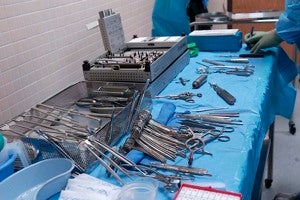
Hospitals are not the cleanest of places. Even in the operating room where the greatest care is taken to create a sterile environment, too often the infectious culprits bacteria, viruses and even fungus are stubbornly present and infect patients under the knife. Today surgical tools are inspected, sterilized and counted by hand and by multiple individuals. It’s an inefficient process that carries a high risk for error. General Electric is trying to streamline surgical tool care in hospitals by taking humans out of the equation and letting a robot do the dirty work.
An infection occurs in 1 to 3 surgery patients out of a hundred. While efforts are constant to minimize surgical site infections – improved operating room ventilation, improved sterilization methods, the use of antimicrobials – they are still the most common type of healthcare-associated infections, accounting for approximately 31 percent of infections contracted by hospitalized patients. Of the 300,000 people that contract surgical site infections each year, about 3 percent will die. And for the 97 percent that survives, an infection can extend hospital stays and inflate medical bills by thousands of dollars.

The robot will use RFID tags to identify and keep track of the scalpels, clamps and other tools it sterilizes. The tags will also identify operating rooms to ensure the instruments end up where they’re supposed to. Later on GE plans on incorporating more advanced technologies like visual pattern recognition for its instrument and operating room verification.
The robot is still in the development stage. But as Lynn DeRose, a Principal Investigator at the Distributed Intelligent Systems Lab at GE Global Research, explained in a press release, the time is ripe for finding ways to automate the surgery room: “…the surgical operation and recovery setting is considered the fastest growing and most resource intensive section of the hospital, accounting for approximately 30 – 50 percent of the hospital’s budget. Simply put, the operating theater is the single largest contributor to a facility’s bottom line. Any gains in efficiency that lead to more revenue being generated will be felt in a big way.”
Dr. DeRose discusses the robot further in the following video.
The project will cost $2.5M and is expected to be completed in two years, at which time the system will be tested at a VA hospital yet to be determined.
Healthcare-associated infections remain a major health concern. In the United States about 1 out of every 20 people who are hospitalized with contract an HAI. In 2002, HAIs affected 1.7 million Americans. In 2009, HAIs cost the US hospitals around $30 billion. As surgical site infections account for a large chunk of this, any measures to reduce them will not only help the bottom lines of both hospital and patient, it’ll also save lives.



